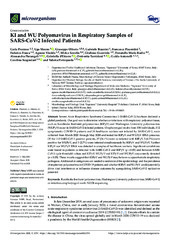KI and WU Polyomavirus in Respiratory Samples of SARS-CoV-2 Infected Patients
Permanent link
https://hdl.handle.net/10037/21730Date
2021-06-09Type
Journal articleTidsskriftartikkel
Peer reviewed
Author
Prezioso, Carla; Moens, Ugo; Oliveto, Giuseppe; Brazzini, Gabriele; Piacentini, Francesca; Frasca, Federica; Viscido, Agnese; Scordio, Mirko; Guerrizio, Giuliana; Rodio, Donatella Maria; Pierangeli, Alessandra; d'Ettorre, Gabriella; Turriziani, Ombretta; Antonelli, Guido; Scagnolari, Carolina; Pietropaolo, ValeriaAbstract
Severe Acute Respiratory Syndrome Coronavirus-2 (SARS-CoV-2) has been declared a global pandemic. Our goal was to determine whether co-infections with respiratory polyomaviruses, such as Karolinska Institutet polyomavirus (KIPyV) and Washington University polyomavirus (WUPyV) occur in SARS-CoV-2 infected patients. Oropharyngeal swabs from 150 individuals, 112 symptomatic COVID-19 patients and 38 healthcare workers not infected by SARS-CoV-2, were collected from March 2020 through May 2020 and tested for KIPyV and WUPyV DNA presence. Of the 112 SARS-CoV-2 positive patients, 27 (24.1%) were co-infected with KIPyV, 5 (4.5%) were positive for WUPyV, and 3 (2.7%) were infected simultaneously by KIPyV and WUPyV. Neither KIPyV nor WUPyV DNA was detected in samples of healthcare workers. Significant correlations were found in patients co-infected with SARS-CoV-2 and KIPyV (p < 0.05) and between SARS-CoV-2 cycle threshold values and KIPyV, WUPyV and KIPyV and WUPyV concurrently detected (p < 0.05). These results suggest that KIPyV and WUPyV may behave as opportunistic respiratory pathogens. Additional investigations are needed to understand the epidemiology and the prevalence of respiratory polyomavirus in COVID-19 patients and whether KIPyV and WUPyV could potentially drive viral interference or influence disease outcomes by upregulating SARS-CoV-2 replicative potential.
Publisher
MDPICitation
Prezioso C, Moens u, Oliveto, Brazzini, Piacentini F, Frasca, Viscido, Scordio, Guerrizio, Rodio, Pierangeli, d'Ettorre, Turriziani, Antonelli, Scagnolari, Pietropaolo V. KI and WU Polyomavirus in Respiratory Samples of SARS-CoV-2 Infected Patients. Microorganisms. 2021;9(1259)Metadata
Show full item recordCollections
Copyright 2021 The Author(s)


 English
English norsk
norsk